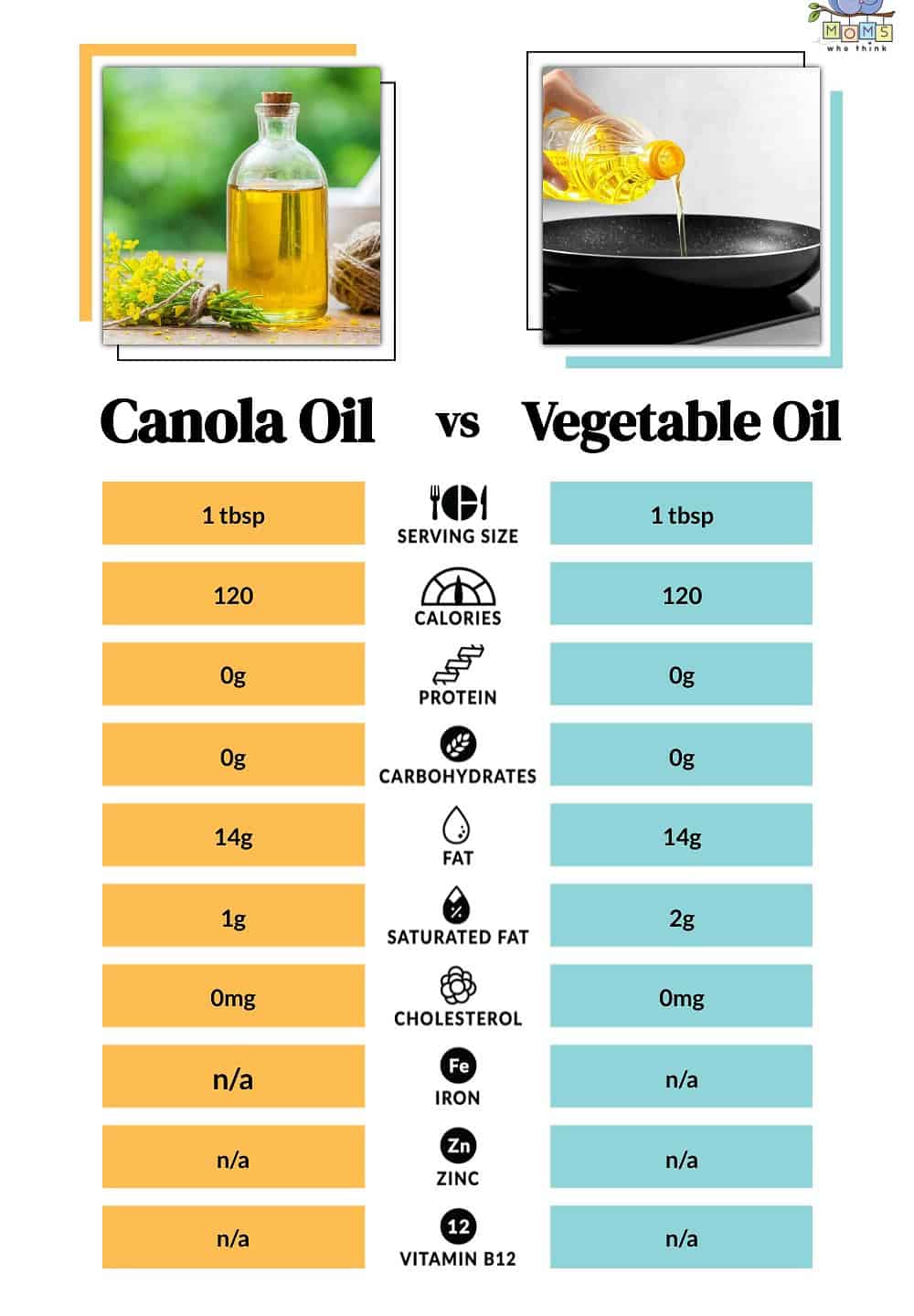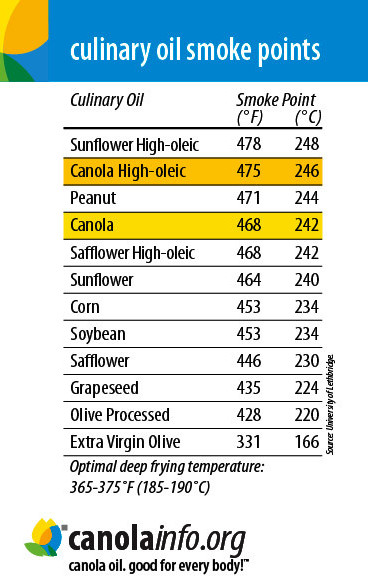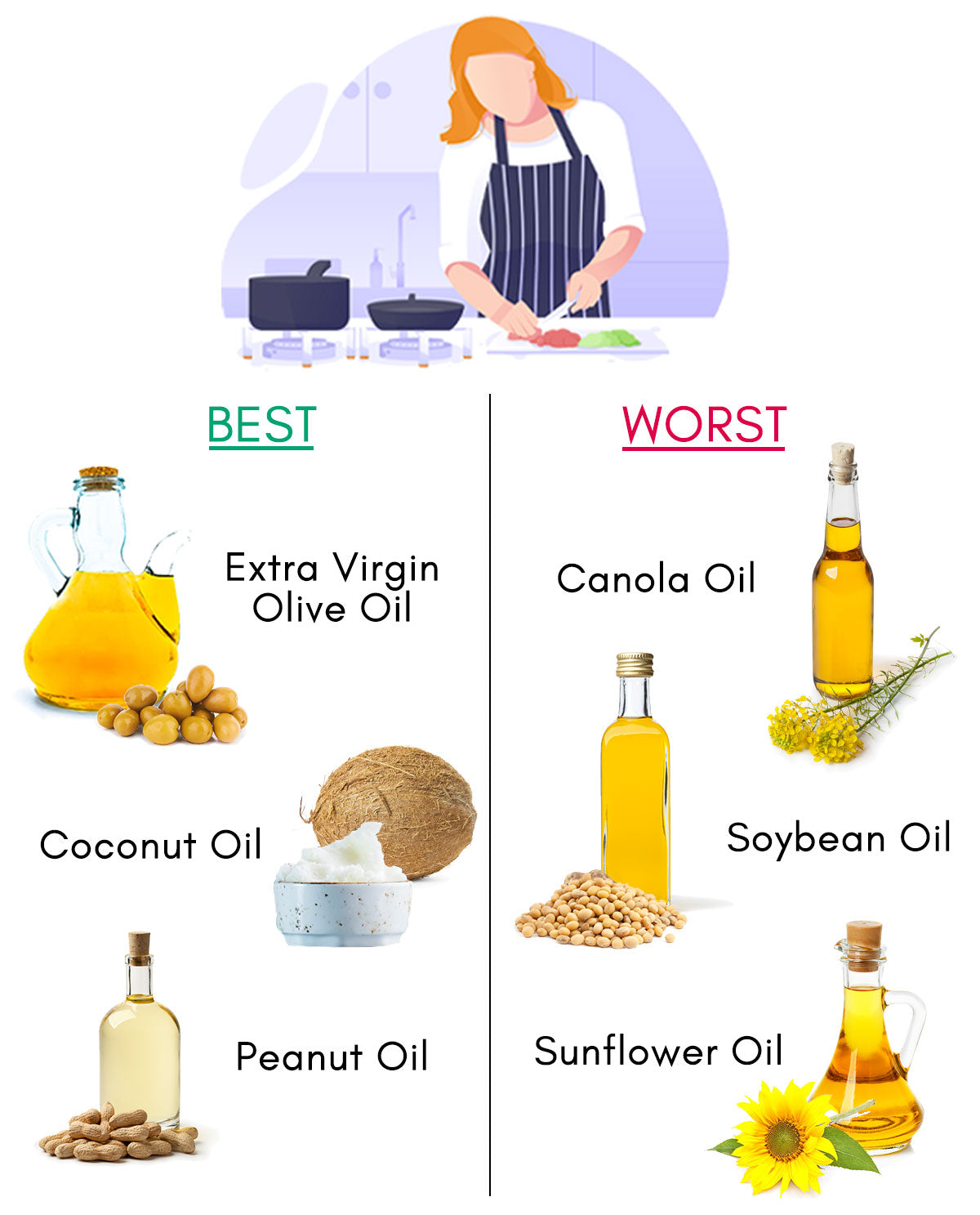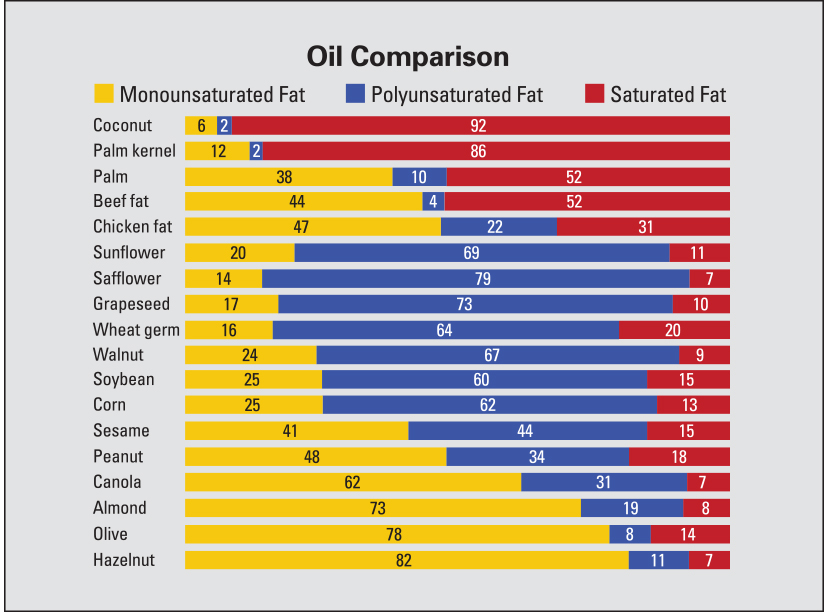Nutritional Comparison

When it comes to comparing the nutritional profiles of soybean oil and canola oil, there are some key differences to consider. Soybean oil is higher in polyunsaturated fats, particularly omega-6 fatty acids, which can promote inflammation when consumed in excess. On the other hand, canola oil has a better balance of monounsaturated and polyunsaturated fats, including omega-6 and omega-3 fatty acids. It also has a lower saturated fat content compared to soybean oil. Additionally, canola oil contains vitamins E and K, providing added nutritional benefits.
Nutritional Values Of Soybean Oil
Soybean oil is rich in essential nutrients, making it a popular choice for cooking. One tablespoon (14 grams) of soybean oil contains approximately 120 calories, 14 grams of fat, and 0 grams of cholesterol. It is a good source of vitamin E, providing about 8% of the recommended daily intake. The oil also contains omega-6 fatty acids, which are beneficial for heart health. However, it’s important to consume soybean oil in moderation due to its high omega-6 content, which can contribute to inflammation when consumed in excess.
Nutritional Values Of Canola Oil
Canola oil is known for its nutritional benefits. One tablespoon (14 grams) of canola oil contains approximately 120 calories, 14 grams of fat, and 0 grams of cholesterol. It is low in saturated fat and high in monounsaturated fat, which can help improve heart health. Canola oil is also a good source of omega-3 fatty acids, providing a healthier balance of omega-6 to omega-3 compared to soybean oil. Additionally, canola oil is rich in vitamin E, which has antioxidant properties. Incorporating canola oil into your diet can contribute to a well-rounded and nutritious meal plan.
Health Benefits

Both soybean oil and canola oil offer various health benefits. Soybean oil is rich in polyunsaturated fats and vitamin E, which have been linked to reducing the risk of heart disease and inflammation. It also contains omega-6 fatty acids, essential for brain function and cell growth. Canola oil, on the other hand, is known for its high monounsaturated fat content, which can help improve heart health and manage cholesterol levels. It also contains omega-3 fatty acids, which have anti-inflammatory properties. Incorporating both oils into your diet can provide a range of nutritional benefits.
Health Benefits Of Using Soybean Oil
Soybean oil offers several health benefits due to its nutrient composition. It is rich in polyunsaturated fats, which can help lower cholesterol levels and reduce the risk of heart disease. The oil is also a good source of vitamin E, a powerful antioxidant that protects the body from oxidative stress and inflammation. Additionally, soybean oil contains omega-6 fatty acids, which play a crucial role in brain function and cell growth. Incorporating soybean oil into your cooking can contribute to a nutritious diet and promote overall well-being.
Health Benefits Of Using Canola Oil
Canola oil offers several health benefits due to its nutritional composition. It is low in saturated fat and high in monounsaturated fat, which can help reduce the risk of heart disease. The oil contains omega-3 fatty acids, which have anti-inflammatory properties and support brain health. Canola oil is also a good source of vitamin E, an antioxidant that protects cells from damage. Incorporating canola oil into your cooking can contribute to a healthy diet and promote overall well-being.
Cooking Performance

When it comes to cooking performance, both soybean oil and canola oil have their strengths. Soybean oil has a high smoke point of up to 475°F, making it suitable for various cooking methods such as frying, sautéing, grilling, and deep-frying. Its mild flavor makes it a popular choice for Asian-inspired dishes like stir-fries and fried rice. On the other hand, canola oil has a lower smoke point, ranging from 225°F to 445°F, depending on the type. This makes it better suited for low to medium heat cooking methods like baking, roasting, and sautéing.
Smoke Point Comparison For Soybean Oil
When it comes to smoke point, soybean oil has a higher tolerance for heat compared to canola oil. Soybean oil has a smoke point of up to 475°F, which makes it suitable for high-temperature cooking methods like frying, sautéing, grilling, and deep-frying. This high smoke point allows for a stable and consistent cooking experience, without the risk of burning or creating unpleasant flavors. Its versatility makes soybean oil a popular choice for a variety of dishes that require intense heat in the cooking process.
Smoke Point Comparison For Canola Oil
Canola oil has a slightly lower smoke point compared to soybean oil, but it still fares well in high-temperature cooking methods. Canola oil has a smoke point of about 400-450°F, making it suitable for frying, sautéing, baking, and grilling. While it may not withstand as high temperatures as soybean oil, it still provides a stable cooking experience without the risk of burning or producing off-flavors. It is a versatile oil that can be used for a variety of cooking applications, making it a popular choice in many kitchens.
Flavor Profiles

Both canola oil and soybean oil have a neutral flavor profile, making them versatile choices for cooking. Canola oil has a very mild, buttery taste, but overall, it is considered to be neutral in flavor. On the other hand, soybean oil is also known for its lack of noticeable taste. Its subtle flavor allows the natural flavors of the ingredients in your dishes to shine through. Whether you are frying, sautéing, or baking, both oils will not overpower the flavors of your dishes, making them suitable for a wide range of recipes.
Flavor Profile Of Soybean Oil
Soybean oil has a neutral flavor profile, with a subtle and mild taste. It is known for its ability to enhance the natural flavors of the ingredients used in cooking. The oil does not overpower the taste of dishes, allowing the flavors of the other ingredients to shine through. Whether you are frying, sautéing, or baking, soybean oil will not alter the original flavors of your recipes. This makes it a versatile choice for a variety of dishes, as it complements the overall taste without adding any distinct or overpowering flavors.
Flavor Profile Of Canola Oil
Canola oil has a mild and light flavor profile, making it a versatile choice for various cooking applications. It has a neutral taste that doesn’t overpower the flavors of other ingredients in recipes. This makes it suitable for both savory and sweet dishes. Canola oil enhances the natural flavors of the food it is used with, making it a popular choice among chefs. Its mild taste allows it to work well in dressings, marinades, baking, sautéing, and frying. Whether you’re making a stir-fry or baking a cake, canola oil complements the overall flavor without adding any distinct or overwhelming taste.
Uses In Cooking

Both soybean oil and canola oil are versatile oils that can be used in a variety of cooking applications.
Soybean oil is commonly used for frying, sautéing, grilling, and even deep frying due to its high smoke point of up to 475°F. Its mild flavor makes it a great choice for preparing Asian-inspired dishes like stir-fries or fried rice.
Canola oil, on the other hand, has a lower smoke point ranging from 225°F to 445°F, depending on the type. It is often used in baking, salad dressings, marinades, and sautés. Canola oil complements the flavors of other ingredients without overpowering them.
Both oils can be incorporated into various recipes to enhance their taste and texture.
Best Uses Of Soybean Oil In Cooking
Soybean oil is a versatile cooking oil that can be used in a variety of ways. Its high smoke point makes it ideal for frying, sautéing, grilling, and even deep frying. The mild flavor of soybean oil also makes it a great choice for preparing Asian-inspired dishes like stir-fries or fried rice. It can be used as a cooking oil for all types of cuisines, adding a subtle richness to your dishes. Additionally, soybean oil can be used in salad dressings, marinades, and even baking, creating moist and flavorful results.
Best Uses Of Canola Oil In Cooking
Canola oil is widely used in cooking due to its versatile nature and mild flavor. It has a high smoke point, ranging from 225°F to 445°F, making it suitable for a variety of cooking methods. Canola oil is commonly used for sautéing and frying, as it adds a subtle richness to dishes while cooking evenly. It is also great for baking, as it helps create moist and tender baked goods. Additionally, canola oil can be used in salad dressings and marinades, adding a light and delicate flavor to your dishes.
Conclusion

In conclusion, both soybean oil and canola oil have their own unique nutritional profiles, health benefits, cooking performances, and flavor profiles. While soybean oil is high in polyunsaturated fats and offers potential health benefits such as reducing inflammation, canola oil contains higher levels of monounsaturated fats and has a higher smoke point, making it more suitable for high-heat cooking. Ultimately, the choice between the two oils depends on individual preferences and specific cooking needs. It is important to consider the smoke point, flavor, and health benefits when selecting the most suitable oil for various cooking scenarios.
Summary Of Key Differences Between Soybean And Canola Oil
Soybean oil and canola oil have some key differences in terms of their nutritional profiles, health benefits, cooking performances, and flavor profiles.
- Soybean oil is higher in polyunsaturated fats and vitamin E, making it a good source of essential fatty acids. Canola oil, on the other hand, has a higher content of monounsaturated fats, which are considered heart-healthy.
- Canola oil also has a higher smoke point, making it more suitable for high-heat cooking methods. Soybean oil has a slightly lower smoke point.
- In terms of flavor, soybean oil has a mild, neutral taste, while canola oil has a more neutral flavor with a hint of nuttiness.
- Both oils have their own uses in cooking, but canola oil is often preferred for frying and high-heat cooking, while soybean oil is commonly used in baking and sautéing.
Overall, the choice between soybean oil and canola oil depends on individual preferences, specific cooking needs, and health considerations.
Recommendations For Specific Cooking Scenarios
https://www.youtube.com/watch?v=y4NRu6XYtWQ&pp=ygUsU295YmVhbiB2cyBDYW5vbGEgT2lsOiBDb29raW5nIE9pbHMgQ29tcGFyZWQ%3D
When it comes to specific cooking scenarios, choosing between soybean oil and canola oil depends on the desired outcome.
For high-heat cooking methods such as frying and deep-frying, canola oil is the preferred choice due to its higher smoke point. Its neutral flavor profile allows the natural flavors of the food to shine through.
On the other hand, soybean oil is well-suited for baking and sautéing. Its mild and neutral taste enhances the flavors of the dish without overwhelming them. It is also commonly used in Asian-inspired stir-fries and fried rice.
Ultimately, the choice between soybean oil and canola oil should be based on individual preferences and the specific cooking needs of the dish.
FAQ About Soybean Vs Canola Oil: Cooking Oils Compared
Q: What is the main difference between soybean oil and canola oil?
A: The main difference lies in their fatty acid composition. Soybean oil contains mostly polyunsaturated fats, while canola oil is high in monounsaturated fats.
Q: Which oil is better for high-heat cooking?
A: Canola oil has a higher smoke point compared to soybean oil, making it more suitable for high-heat cooking methods like frying and baking.
Q: Are there any health differences between soybean and canola oil?
A: Canola oil is considered heart-healthy due to its low saturated fat content and high levels of omega-3 fatty acids, while soybean oil may contribute to higher omega-6 intake.
Q: Can both oils be used interchangeably in recipes?
A: Yes, both oils can generally be used interchangeably in recipes that call for a neutral-tasting oil. However, consider the flavor profile and smoke point when substituting one for the other.
Q: Which oil is more cost-effective?
A: Soybean oil is often more economical compared to canola oil, making it a popular choice for those looking for a budget-friendly cooking oil option.
Q: Are soybean and canola oils suitable for a vegan diet?
A: Both soybean and canola oils are plant-based oils and are suitable for a vegan diet, as they are derived from soybeans and canola seeds, respectively.

Kostas Mediterranean is a family-owned Greek restaurant located in North Vancouver. Our passion for bringing the authentic flavors of Greece to the local community has been the driving force behind our establishment. We take pride in offering a warm and welcoming atmosphere where guests can experience the true essence of Greek hospitality. Our journey began with Kostas, whose culinary skills and love for Greek cuisine inspired the creation of the restaurant. With a desire to share his family recipes and traditions, Kostas set out to create a dining experience that captures the spirit of Greece. The result is a menu that showcases a delightful blend of traditional and modern Greek dishes prepared with the finest and freshest ingredients.